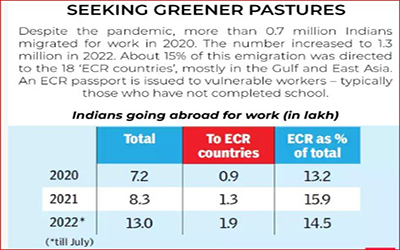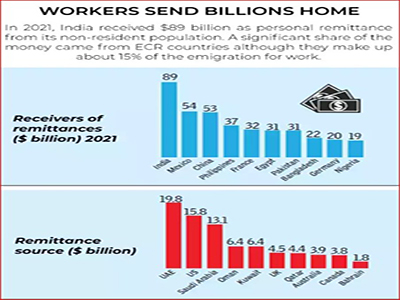Date: 19/05/2023
Relevance: GS-1: Effects of globalization on Indian society
Key Phrases: demographic advantage, Industrial economies, Aging Population, Immigration Policies, Globalization, Brain Drain, Economic Diplomacy, Social Disruption.
Context:
- India's demographic advantage, with a large English-speaking and youthful population, presents a unique opportunity to meet the increasing global demand for labor.
Key Highlights:
- Germany predicts a shortage of seven million workers by 2035, with hundreds of thousands of unfilled job vacancies in 2022.
- Industrial economies like the US and Japan are recognizing the need for foreign talent to maintain their technological and economic leadership.
- Industrial economies are shifting their stance on immigration and actively competing to attract skilled immigrants.
- India's large population, particularly its youthful segment, positions it as a potential permanent supplier of unskilled, semi-skilled, and high-skilled labor.
Do you Know?
- The UAE, the US and Saudi Arabia host the largest number of migrants from India.
- India is expected to receive about $100 billion in remittances from its worldwide diaspora of 32 million immigrants.
- Other countries with a large diaspora population included Mexico and Russia (11 million each), China (10 million) and Syria (8 million).
- More than 1.6 million Indians have renounced their citizenship since 2011, including 1,83,741 in 2022.
- The United States remains the main draw for Indians moving abroad and gaining citizenship in other countries.
- Most Indians transferred their citizenship to the United States (78,284), followed by Australia (23,533), Canada (21,597) and the UK(14,637).
Why world is Currently Experiencing Labour Scarcity ?
- Aging Population: Many countries are facing an aging population, with a declining birth rate and increasing life expectancy. This demographic shift has led to a decrease in the available workforce, resulting in labor scarcity.
- Skills Mismatch: There is often a mismatch between the skills possessed by the available workforce and the skills required by industries. Technological advancements and changing market demands have created a need for workers with specific skills, leading to a shortage of qualified individuals in certain sectors.
- Economic Growth: Rapid economic growth in many countries has increased the demand for labor across various industries. The expansion of sectors such as technology, healthcare, and construction has created a shortage of skilled workers.
- Low Birth Rates: Some countries are experiencing low birth rates, resulting in a smaller pool of young individuals entering the workforce. This demographic trend contributes to labor scarcity, particularly in sectors that require a large number of workers.
- Immigration Policies: Stringent immigration policies or restrictions can limit the influx of foreign workers into countries facing labor shortages. These policies may be implemented due to political considerations or concerns about the impact of immigration on local employment.
- Globalization: Increased globalization has created new opportunities and markets for businesses worldwide. As companies expand their operations globally, the demand for labor in different regions intensifies, leading to labor scarcity in certain areas.

Challenges, Opportunities, and Implications of India Becoming a Major Supplier of Labor to Aging Societies:
- Challenges:
- Brain Drain: The emigration of highly skilled individuals may deplete India's talent pool and hinder domestic development and innovation.
- Socio-economic Impact: Large-scale emigration may lead to labor shortages in certain sectors, impacting domestic industries and causing wage inflation.
- Social Disruption: Emigration may lead to the separation of families, brain drain from rural areas, and cultural dislocation for migrants, impacting social cohesion.
- Economic Dependency: Over-reliance on remittances as a source of foreign exchange can create vulnerability to external economic fluctuations.
- Opportunities:
- Remittances: Indian migrants sending remittances back home can contribute to the country's foreign exchange reserves, promote consumption, and support development projects.

- Skill Enhancement: Migrants returning to India after gaining valuable skills and experiences abroad can contribute to knowledge transfer, innovation, and entrepreneurship.
- Economic Growth: Remittances and the return of skilled migrants can boost domestic investment, entrepreneurship, and economic growth.
- Social Transformation: The integration of Indian immigrants in host societies can foster cultural exchange, enhance India's global image, and strengthen people-to-people ties.
- Shaping Foreign Policy:
- Economic Diplomacy: Indian immigrants contribute significantly to the economies of host countries, leading to stronger bilateral economic ties and influencing foreign policy decisions.
- Diaspora Engagement: The Indian diaspora acts as a bridge between India and their host countries, fostering cultural exchange, trade partnerships, and diplomatic relations.
- Political Influence: Indian immigrants who hold positions of power and influence in their host countries can shape foreign policies that align with India's interests.
- Enhancing Soft Power:
- Cultural Influence: Indian immigrants showcase India's rich cultural heritage through festivals, cuisine, music, dance, and arts, thereby increasing global appreciation and understanding of Indian culture.
- Education and Research: Indian immigrants contribute to research, innovation, and academic excellence in host countries, enhancing India's reputation in fields such as science, technology, and academia.
- Sports and Entertainment: Indian immigrants excelling in sports, film, and entertainment industries act as cultural ambassadors, popularizing Indian talent and narratives globally.
- Promoting India's Values:
- Social Contributions: Indian immigrants engage in philanthropic activities, community development, and social initiatives, reflecting India's values of compassion, inclusivity, and social responsibility.
- Yoga, Ayurveda, and Spirituality: Indian immigrants contribute to the popularity and acceptance of traditional Indian practices like yoga, Ayurveda, and meditation, promoting India's holistic approach to health and well being.
- Advocacy for Global Issues: Indian immigrants actively participate in international forums, advocating for issues like climate change, sustainable development, gender equality, and human rights, showcasing India's commitment to global challenges.
- Demographic dividend:
- Immigration may also be the silver bullet that India needs to realise its demographic dividend and ensure long-term domestic stability.
- With the world’s largest population, India faces the unenviable task of providing decent jobs to her labour force of 500 million, with 12 million new entrants seeking employment every year.
- With large levels of learning poverty, crumbling educational infrastructure, and high rates of information, we face the grim possibility of underemployment for hundreds of millions of Indians.
What Policy Measures Can be Taken?
- Skill Development: Emphasize skill development programs to equip the Indian workforce with in-demand skills, aligning training with the needs of industries and foreign labour markets.
- Streamlined Immigration Policies: Implement clear and efficient immigration policies that attract and retain foreign talent, ensuring ease of entry, work permits, and residency for skilled professionals.
- Education Collaboration: Foster partnerships between Indian and foreign universities to enhance educational opportunities, promote knowledge exchange, and create a talent pool capable of meeting global demands.
- Language Training: Provide language training programs to enhance the employability of Indian immigrants in host countries and facilitate effective communication and integration.
- Skilled Labor Retention: Implement policies to incentivize skilled professionals to stay in India by creating favorable work environments, career opportunities, and competitive compensation.
- Social Security and Welfare: Establish mechanisms to ensure the welfare and protection of Indian migrants abroad, including access to healthcare, legal assistance, and social security benefits.
- Diplomatic Engagement: Strengthen diplomatic efforts to negotiate favorable immigration agreements with host countries, ensuring the protection of Indian workers' rights and promoting their well-being.
- Entrepreneurship Support: Provide support and incentives for returning migrants to establish businesses, contribute to domestic innovation, and create employment opportunities.
Conclusion:
- India's emergence as a major supplier of labor to aging societies presents both challenges and opportunities.
- While addressing brain drain, social disruption, and economic dependency, India can leverage remittances, skill enhancement, and global engagement for economic growth and social transformation.
- Implementing policy measures focused on skilled labor retention, skill development, social security, diplomatic engagement, and entrepreneurship support will help manage the impact of large-scale immigration effectively, ensuring the overall benefit of India's economy, society, and global engagement.
Source: The Hindu BL
Mains Question:
Q. Evaluate the potential economic benefits of immigration for India, considering its large population and the global demand for skilled and unskilled labor. Discuss the measures that can be taken to harness this potential and ensure long-term domestic stability. (250 Words).








